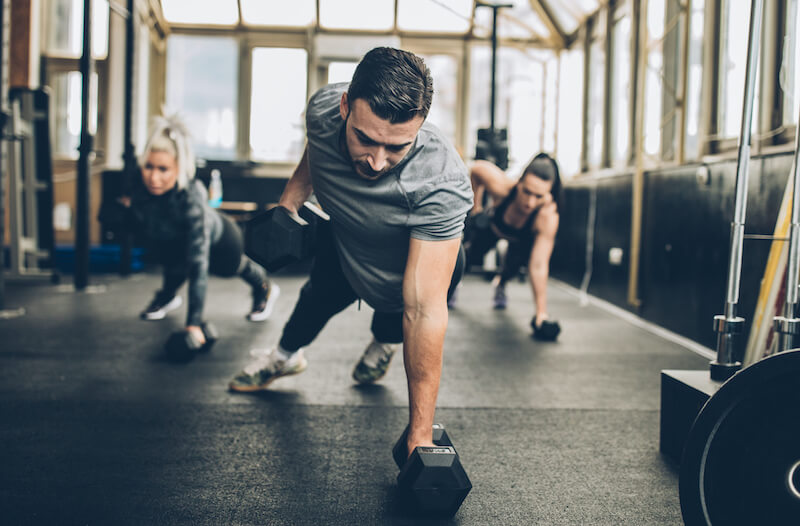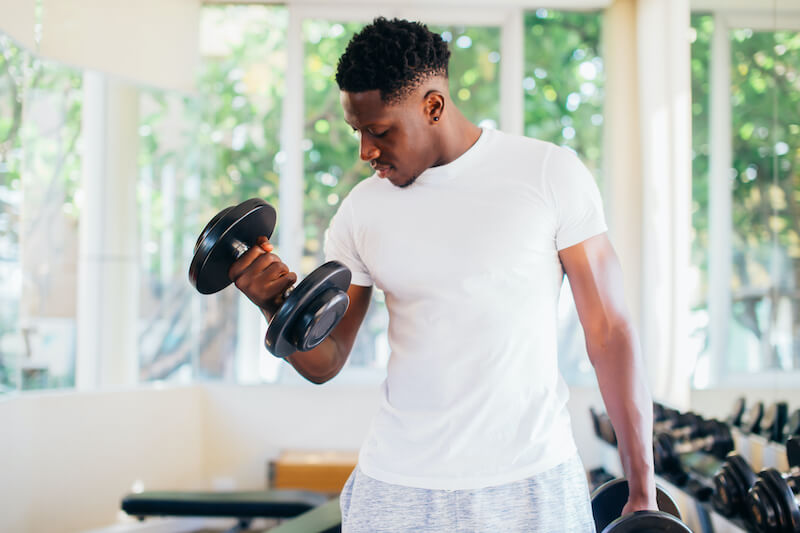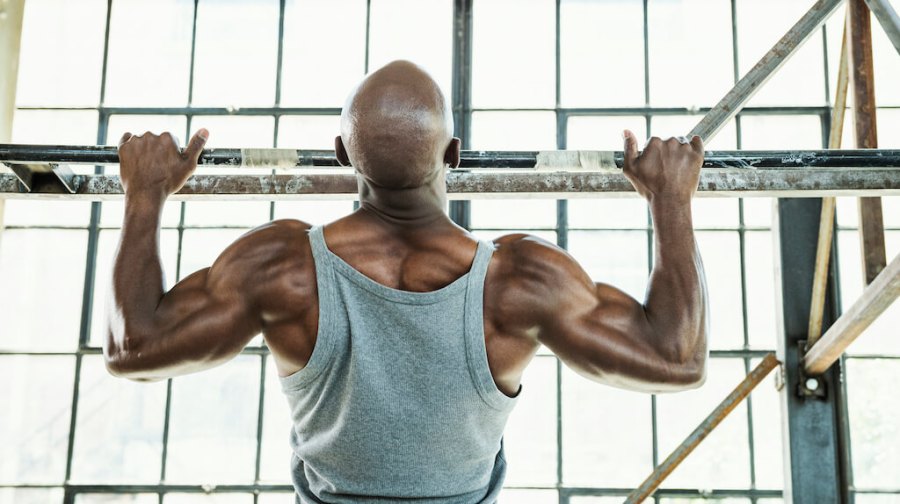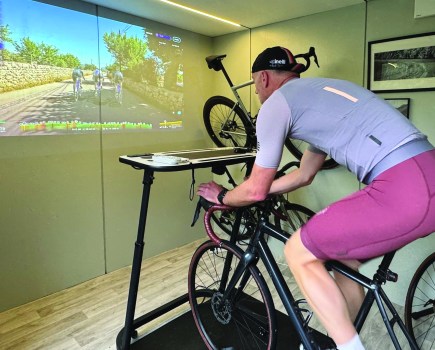If you’re just getting started in the world of strength training, a million and one different questions are bound to be floating around in your head. Whether you’re looking to burn body fat or build a six-pack, it can be tricky to know where to start.
From how often you should train to the low-down on free weights verses machines, we’re here to answer your common strength training FAQs.
Strength training FAQs
Why am I not building muscle?
If your efforts to build muscle have been unsuccessful in the past, this had nothing to do with your body being fundamentally resistant to exercise and everything to do with your approach. In other words, you didn’t have a focused plan, didn’t set realistic, achievable goals or didn’t eat the right foods – or some combination of the three.
Anyone can make positive changes to the way they look, but that’s not going to happen overnight. Going to the gym once or twice a week won’t give you a radical transformation, especially if you don’t work hard or aren’t eating well.

Can I turn my body fat into muscle?
Fat and muscle are two totally different types of tissue, so it’s impossible for one to turn into the other. Muscle is active tissue that burns calories, while fat tissue stores excess energy.
When you train hard you burn away fat and build muscle, giving an appearance that one has turned into the other, but that’s not actually the case.
How often should I work out to build muscle?
Less frequently than you might think. And it’s certainly not the case that more is better. That’s because it’s actually when you’re recovering that your muscle size and strength increases. If you don’t take the time to recover sufficiently you won’t see improvements.
It’s not just your muscles that need time to recover; your nervous system is working hard to recruit your muscles, something it’s not used to doing, so it also needs time to recover.
How long should each workout last?
The perfect workout should take less than an hour to complete, including warm-up, warm-down and stretching.
Research suggests that your levels of the growth hormone testosterone peak around 45 minutes into a workout and then quickly subside as your levels of cortisol, the stress hormone that breaks down muscle tissue and damages cells, rise. So keep your workouts short and effective.
Should I do cardio if I’m trying to build muscle?
One of the most common strength training FAQs. The answer, in short, is yes. Incorporating cardio into your routine can benefit muscle building by improving cardiovascular health and enhancing recovery. However, moderate the amount to avoid excessive calorie burning, which could hinder muscle gain. Aim for 2-3 sessions of low-impact cardio each week to complement your strength training.
How important is nutrition?
Nutrition is critical, as it fuels workouts, aids recovery, and supports muscle growth. A diet rich in protein, healthy fats, and carbohydrates ensures your body has the necessary tools to repair and build muscle. Consider consulting with a nutritionist to tailor a dietary plan that aligns with your fitness goals.
Do I need to take supplements to build muscle?
While not mandatory, the best supplements can support your muscle-building journey. Protein powders, creatine, and branched-chain amino acids (BCAAs) are popular choices that can help meet nutritional needs, enhance performance, and improve recovery. However, focus on a balanced diet first and consider supplements as complementary.
What is progressive overload, and why is it important?
Progressive overload is a practice where you gradually increase the intensity of your workouts by adding weight, reps, or sets. This concept is crucial for continued muscle growth as it challenges your muscles, prompting them to adapt and become stronger over time. Without progressive overload, muscle gains typically plateau.

Are free weights better than machines?
Resistance machines have their place in a gym: they’re a great way for beginners to learn movement patterns without the risk of injury, and they allow experienced trainers to isolate specific muscles to lift more weight. But because the movement is restricted, they won’t work the stabilising muscles that are so important in keeping you free of injury.
Using free weights may require more skill, but it will recruit those stabilising muscles and better prepare your body for other activities, especially sports.
How does sleep affect muscle growth?
Sleep is vital for muscle recovery and growth. During deep sleep, the body releases growth hormones that help repair and build tissue. Aim for 7-9 hours of quality sleep per night to optimize muscle recovery and performance. Establishing a regular sleep routine can significantly enhance your training results.
Should I work out if I’m sore?
Experiencing soreness after exercise is normal, especially if you’re new to training or have increased workout intensity. While mild to moderate soreness shouldn’t prevent you from working out, listen to your body. Engage in light activity or active recovery if necessary, and allow heavily sore muscles time to rest.
Can I do strength training at home without equipment?
Yes, you can effectively do strength training at home without equipment using bodyweight exercises like push-ups, squats, lunges, and planks. Use everyday items, such as backpacks filled with books, as weights to increase resistance. We’ve got a whole host of bodyweight workouts for you to try.
How do I prevent injuries during strength training?
Prevent injuries by warming up properly before workouts, focusing on correct form, and not rushing through exercises. Pay attention to your body’s signals and avoid lifting weights that compromise your form. Stretching regularly and incorporating rest days into your routine can also help maintain muscle and joint health.

Are lighter weights better for toning?
‘Toning’ is one of the most popular words in the exercise world. It is also one of the most redundant. You can’t ‘tone’ a muscle, only build it or maintain it, while stripping away fat to give it a more prominent appearance. So when people say they want to ‘tone up’ they actually mean that they want to add muscle, lose fat or a bit of both.
Do crunches build six-pack abs?
You can perform hundreds of crunches every day and have the strongest abs in the world, but if they’re under a layer of fat then you’re not going to see them.
And if you’re trying to burn fat, crunches are just about the worst move you could choose – in fact, you’d have to do about 500,000 of them to burn 1kg of fat. That’s about four weeks of non-stop crunching.
How quickly can I build muscle?
Don’t expect overnight success. You need to lift heavy weights regularly to stimulate the muscle into growing, eat a diet of high-quality protein and carbs with no junk and get plenty of sleep. It’s a big commitment.
Are squats bad for my knees?
Performed incorrectly, any move is dangerous, although squats have a particularly bad reputation. But a correct squat – in which your feet are shoulder-width apart and your knees stay in line with your toes – places emphasis on the quads, glutes and hamstrings, and not on any joints. This can reduce the risk of injury by strengthening the muscles and supporting tissues around the knee joint.
Can you build muscle mass with bodyweight exercises?
If you’re new to training or returning from injury, bodyweight moves are the perfect preparation for heavier lifts. They can also be used effectively as part of supersets or bodyweight circuits, and are far better at building strength and stability in your joints and core than resistance machines.






